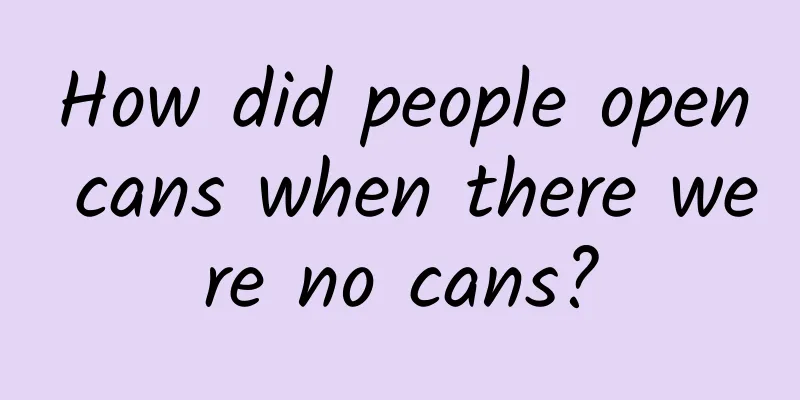How did people open cans when there were no cans?

|
Why not just change the name of the can to the difficult-to-pull can! No matter how strong a person is, he or she has to be careful when pulling the can. To pull the can open, not only does one need to master the right amount of strength, but also some luck: if the strength is too weak, the finger can't even pull the ring open; but if the strength is too strong and the ring breaks, all the skills of a lifetime will be sealed in this thin piece of iron. Cans are the worst hit. Every time I open a can, I worry not only about whether my nails will break, but also whether the pull ring will fall off. If this continues, I might really go crazy. If Archimedes, the master of lever, came to the modern era and found that people had spent thousands of years without using the principle of lever to open an iron can, he might immediately withdraw his statement of "using a fulcrum to lift the earth." Although it is frustrating to be unable to open a jar, it only hurts your heart. For some people, this small pull ring can cause more than just that. Who hasn’t been a victim of a can? When cans were first invented, all pull rings were flip-out, meaning they were pulled down with the lid. At the time, using this pull ring as a ring had become a classic part of romantic love stories. But in real life, it is not only not romantic at all, but also "harms" many people: we can easily get our fingers cut by the iron sheet that is pulled down, and the pull ring that is thrown away can often hurt people for no reason. The pull ring can be directly included in the list of hidden weapons! Of course, not to mention the pull tabs that enter the human body. In the 1970s, pediatricians reported more than a dozen cases of accidental ingestion of pull tabs. The consequences of swallowing them are unimaginable: the sharp edges of the pull tabs can easily cut internal tissues, and an 11-month-old baby even lost his life because of the impact on the aortic arch. Generally speaking, aluminum has a low radiodensity and is more transparent to X-rays than other metals. It looks similar to soft tissue on X-rays, so it is difficult for doctors to detect it through X-rays. A recent case report said that a patient did not find a piece of aluminum in his body until the fourth year of abdominal pain. However, the location of the pull ring was very obvious - probably because it had been in the patient's body for four years and its properties had changed. Doctors finally removed the pull ring through surgery. No matter what kind of pull ring it is, breaking it is a world-class problem that leaves us helpless. Some merchants like to be "smart" and even prying open the pull ring challenges the limits of our fingers, not to mention the difficult action of pulling it open. Anyone who has been hurt by a pull ring hopes that this anti-human design will disappear from the world! Wait, a world without pull tabs might be a harder place. How did people open cans when there were no cans? The tradition of packaging food in metal cans is very old, with tinplate cans used to store seafood and fruit dating back to the early 19th century, with instructions on the cans: if you wanted to open it, you had to "cut a circle in the top of the can with a chisel and hammer." It was a bit troublesome, but people at that time believed that food in cans was the safest! To open a can, people had to use powerful tools. After another 30 years, various can openers came into being, but for ordinary consumers, these tools were so difficult to use that they wanted to smash them with a hammer. It was not until 1892 that a useful thing was finally made! This is the "tin key". The can key is similar to a special chisel. Using it to open a can is actually to chisel two holes in the can. In 1925, people finally invented the greatest invention in the can industry - the two-wheel can opener. But these can openers are still "external objects" of cans. If you don't have a can opener at hand when you want to eat canned food, it may really drive you crazy. Engineer Ermal Fraze was one of them. In 1959, he wanted to drink beer at a family picnic, but he didn't have a can opener at hand, so he had to pry it open with the car bumper. But he was adamant there had to be an easier way to open the can. After a sleepless night, he invented the can. This device that can open the can instantly without additional tools was a huge improvement at the time. The pull ring also evolved step by step to become easier to pull. For example, the pull ring became larger and more suitable for fingers to pull; the rivet that fixed the pull ring was also stronger. Until the late 1970s, the embedded pull ring came out and gradually replaced the pull ring to become the mainstream and has dominated to this day. This pull ring left on the can body not only solves some of the pull ring recycling problems, but also avoids some human injuries. But the fragile connection point cannot prevent the pull ring from falling off, and these pull rings scattered around the world have even spawned a "pull ring archaeology". Jobbe Wijnen, who is very interested in pull rings, has collected more than 8,000 pull rings, discovered and classified them. The collection of pull rings at Jobe is still ongoing, but in addition to archaeology, can someone quickly develop a "can opening success science"? It really doesn't work... Pull the ring with the pull ring How could people who are good at inventing tools stop there? Faced with the problem of the pull ring being difficult to open, clever humans came up with an idea: Why not make a big pull ring to pull the small one? Although the "can pull ring openers" on the Internet have different styles, their functions are similar: giving the pull ring an extra "handle". I didn't expect that cans have developed to the point where tools are needed to open them. Although you can use some hard tools (metal spoons, flat picks) to poke open cans or tins with the rings missing, there are still risks. Especially for soda cans, there are also instructions on the Internet to rub the outer surface to make the carbon dioxide "break" the opening, but this method of "blasting" cans also has risks. You might as well collect these hard-to-open cans with broken pull tabs. After a few of them break, you will definitely want to buy a special can opener... References [1] https://pulltabarchaeology.com/archaeology/ [2] https://www.hmpgloballearningnetwork.com/site/gastro/articles/foreign-body-ingestion-beverage-can-tab [3] Donnelly, Lane F. "Beverage can stay-tabs: still a source for inadvertently ingested foreign bodies in children." Pediatric radiology 40.9 (2010): 1485-1489. [4] Elghouche, Alhasan N., Brian C. Lobo, and Jonathan Y. Ting. "Aspiration of aluminum beverage can tab: case report and literature review." Case Reports in Otolaryngology 2017 (2017). [5] Ogrydziak, Cole E., John W. Kirkland, and Edward M. Falta. "The aluminum beverage TAB and a soldier with chronic abdominal pain." Radiology Case Reports 16.1 (2021): 51-54. [6] https://www.nytimes.com/1989/10/28/obituaries/ec-fraze-76-designed-pull-tab.html Author: Chen Mo Editor: Owl, Window Knocking Rain Title image: Alex/imgur, modified Guokr (ID: Guokr42) If you need to reprint, please contact [email protected] Welcome to forward to your circle of friends Source : Guokr |
<<: Can taking too much vitamins cause death? Learn more about vitamins in one article!
>>: A "sky bridge" connects the "natural chasm" to make space exits easier
Recommend
Brand online promotion manual!
Global growth is the only way for brands. The abo...
You can make money by posting pictures on Tik Tok! The practical document is worth 1,299 yuan and is full of useful information!
You can make money by posting pictures on Tik Tok...
Zhou Yanjie lady body 10-session quick slimming yoga: 360° body sculpting, making you slim, light and elegant!
Zhou Yanjie lady body 10-session quick slimming y...
The latest global mobile phone shipment data: Android is more ahead
The latest report released by market research fir...
Sogou's IPO: Wang Xiaochuan's hopes and worries
On the evening of October 9th, Beijing time, Sogo...
PPT logical aesthetics, logical aesthetics Baidu network disk resources!
PPT Logical Aesthetics Use "Edit Vertex"...
2022 Postgraduate Entrance Examination Political Science Course Resources - Gaotu, Xinwendao, Haitian, Wendu, New Oriental, Xiao Xiurong Postgraduate Entrance Examination Political Science
17. 2022 Yu Feng 16. 2022 Higher Education Online...
It was revealed that Depp's ex-wife cheated on Musk during their marriage, and the intimate scene in the elevator was exposed, it was simply unbearable to watch!
Sina Entertainment News: According to foreign med...
How much does it cost to attract investment in the Haikou children’s clothing mini program? What is the investment quotation for the Haikou children's clothing mini program?
How much does it cost to invest in the Haikou chi...
Is it a rumor that spinach is high in iron?
We have heard countless rumors and lies since we ...
Intelligent driving will accelerate development, and GAC Aion will become the leader in L3
On February 18, Guangdong Province held a provinc...
Xiaomi joins hands with Hatsune Miku to launch customized products. Why do domestic mobile phones need Japanese fake girls to save them?
The Redmi Note 4X, which will be released on Valen...
Which mini program company in Shanghai has a better reputation? Which mini program development company in Shanghai is the best?
Which mini program company in Shanghai has a bett...
In addition to being ugly, the bangs on the iPhone X will also cause these new problems
Discussions like "Apple is dead" appare...
Aiti Tribe Story Collection (11): Programming from 0 to 1
[51CTO.com original article] Aris became interest...






![[Promotion Case] How was the campaign that brought about a net increase of 60,000 users in 6 days created?](/upload/images/67cc40acb90fb.webp)


